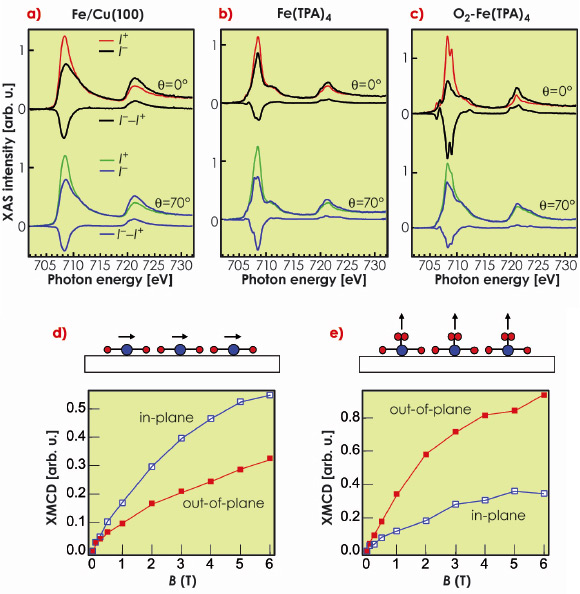- Home
- Users & Science
- Scientific Documentation
- ESRF Highlights
- ESRF Highlights 2009
- Electronic structure and magnetism
- Supramolecular control of the magnetic anisotropy in two-dimensional high-spin Fe arrays at a metal interface
Supramolecular control of the magnetic anisotropy in two-dimensional high-spin Fe arrays at a metal interface
The control of magnetic anisotropy is important for the development of metal-organic materials for magnetic applications, both at the single molecule and extended film level [1]. In so-called single molecule magnets, this is achieved by chemical modification of the environment and variations in the number of metal ions that carry the magnetic moment. For metal-organic layers in contact with a metal substrate o r electrode, however, it was unclear whether such a strategy would be effective and whether these layers would display electronic and magnetic properties that are typical of molecules or metals. Experiments at beamline ID08 using a combination of scanning tunnelling microscopy (STM), X-ray magnetic circular dichroism (XMCD), and charge transfer multiplet calculations have provided a response to these questions.
Co-deposition of transition-metal ions and organic ligands on single-crystal surfaces offers the potential to design supramolecular metal-organic grids with programmable structural features, where the interaction with the substrate is used to stabilise a planar geometry [2]. This approach was favoured over the deposition of magnetic molecules synthesised in solution, since it allows a more direct comparison of the electronic configuration of the magnetic sites depending on the ligand and metallic environment. Figure 80 shows the supramolecular assembly of Fe and terephthalic acid (TPA) molecules on a Cu(100) surface. Each Fe atom is coordinated to four TPA molecules through Fe-carboxylate bonds, with supramolecular Fe(TPA)4 units organised in a square lattice with 15x15 Å2 periodicity. STM images indicate that, despite the 4-fold lateral coordination to the carboxylate ligands and the residual interaction with Cu, Fe centres are chemically active, forming an array of open coordination sites that may selectively bind other ligands, for example O2 forming pyramidal-like O2-Fe(TPA)4 complexes.
 |
|
Fig. 80 : Planar supramolecular layers of Fe-TPA complexes self-assembled on Cu(100). a) ball and stick model of Fe(TPA)4 array as calculated by density functional theory. Blue dots indicate the position of Fe atoms, red O, black C, white H; the green halo represents the spin density. b) O2-Fe(TPA)4 array. c) STM image of a Fe(TPA)4 monolayer grown on Cu(100). Selective uptake of O2 by Fe sites is indicated by a change of STM contrast (white spots). Lateral image size is 84 x 84 Å2. |
Pristine and O2-saturated Fe(TPA)4 monolayers were prepared and characterised in situ, exploiting the UHV STM facility connected to the XMCD end-station. X-ray absorption spectra (XAS) were recorded at the L2,3 edges of Fe and K-edge of O, in magnetic fields of up to 6 T with the sample held at 8 K. The results (Figure 81), interpreted with the aid of charge transfer multiplet calculations, show that the Fe d-orbitals interact mainly with the O ligands and are only weakly perturbed by the metallic substrate. Furthermore, both Fe(TPA)4 and O2-Fe(TPA)4 constitute high-spin Fe2+ complexes, against the tendency of the Cu electrons to reduce the Fe moment via 4s-3d hybridisation and Kondo screening.
Angle-dependent XMCD measurements revealed strong in-plane magnetic anisotropic of Fe(TPA)4 complexes opposite to Fe/Cu(100) (Figure 81d) and that the easy axis direction can be controlled by the symmetry of the ligand bonds, independently from the metal substrate. Apical O2 ligands at Fe sites drive an abrupt spin reorientation transition, rotating the Fe easy axis out-of-plane and favouring the formation of an unusually strong orbital moment of about 0.55 ± 0.07 µB per Fe atom. With respect to bulk molecular crystals, the planar and open coordination structure of the self-assembled Fe array makes such a system extremely sensitive to chemisorption, providing straightforward control of the preferred Fe spin orientation.
 |
|
Fig. 81 : Circularly polarised XAS of a) 0.025 monolayers Fe/Cu(100), b) Fe(TPA)4, and c) O2-Fe(TPA)4 for parallel (I+) and antiparallel (I-) orientation of the photon helicity with field-induced magnetisation. Spectra were recorded in the electron-yield mode at normal ( |
In conclusion, we have demonstrated that it is possible to construct planar metal-organic networks and to control their magnetic properties at the interface with a metal substrate. This constitutes an essential step towards the inclusion of molecular materials into heterogeneous magnetoelectronic devices.
References
[1] L. Bogani and W. Wernsdorfer, Nat. Mater. 7, 179 (2008).
[2] S. Stepanow, N. Lin and J.V. Barth, J. Phys. Condens. Matter 20, 184002 (2008); M.A. Lingenfelder et al., Chem. Eur. J. 10, 1913 (2004).
Principal publication and authors
P. Gambardella (a,b), S. Stepanow (a,c), A. Dmitriev (c), J. Honolka (c), F. de Groot (d), M. Lingenfelder (c), S.S. Gupta (e), D.D. Sarma (e), P. Bencok (f), S. Stanescu (f), S. Clair (g), S. Pons (g), N. Lin (c), A.P. Seitsonen (h), H. Brune (c), J.V. Barth (i) and K. Kern (c,g), Nat. Mater. 8, 189 (2009).
(a) Centre d’Investigacions en Nanociència i Nanotecnologia (ICN-CSIC), UAB Campus, Barcelona (Spain)
(b) Institució Catalana de Recerca i Estudis Avançats (ICREA), Barcelona (Spain)
(c) Max-Planck-Institut für Festkörperforschung, Stuttgart (Germany)
(d) Department of Chemistry, Utrecht University (The Netherlands)
(e) Solid State and Structural Chemistry Units, Indian Institute of Science, Bangalore (India)
(f) ESRF
(g) Institut de Physique de la Matière Condensée, Ecole Polytechnique Fédérale de Lausanne (EPFL), Lausanne (Switzerland)
(h) Institut de Minéralogie et de Physique des Milieux Condensé, Université Pierre et Marie Curie, Paris (France)
(i) Physik-Department E20, Technische Universität München, Garching (Germany)



